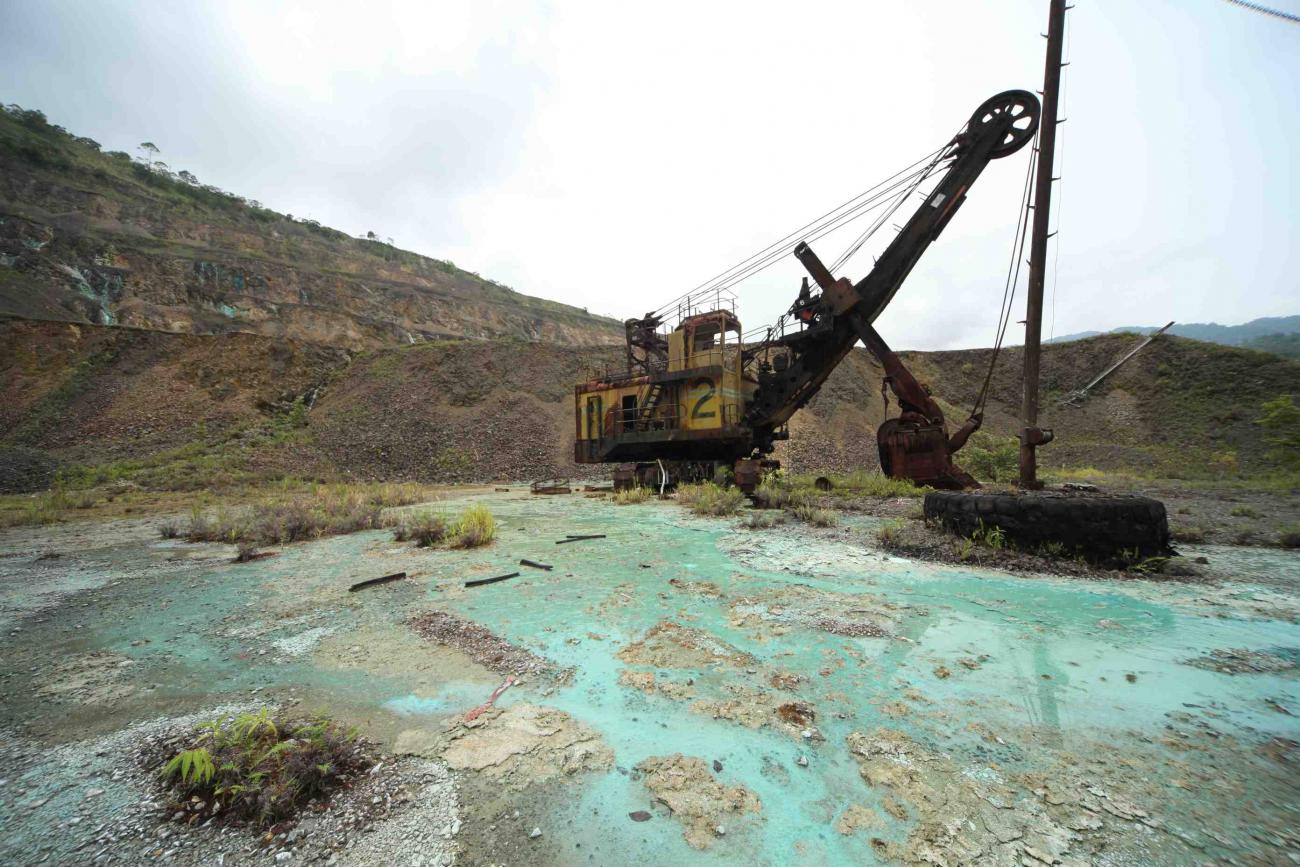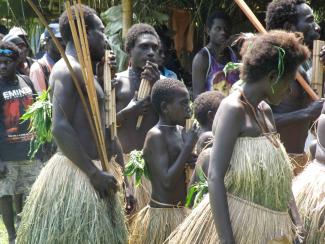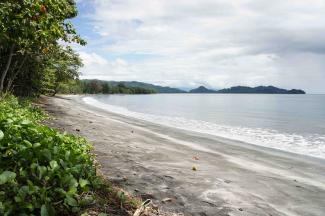
By Timothy King
A decade long war in Papua New Guinea has left deep scars on Bougainville and its people. Some will never be erased, others may fade with time.
Many of the horrors experienced are unimaginable. Speaking from her hospital bed in December 1999, Cecillia recalls her treatment at the hands of the Papua New Guinea Defence Force (PNGDF):
A military policeman named Robin Monai raped me. He buggered me and he raped me wearing a coffee mug handle on his penis — he called it a bearing. This caused me internal damage. This man is still here in Buka and nothing has been done to correct this injustice. This is a man who used to cut the ears off and then kill our men. He is still here. Nothing has been done; there is no justice.
In the deceptively beautiful surrounds of Bougainville – a mineral rich island which lies on Papua New Guinea’s (PNG) eastern border – painful memories such as this are replayed every day.
Sadly political leaders on Bougainville charged with responsibility for peace-building have largely abrogated their domestic and international obligation to challenge impunity and seek redress for victims of gross human rights violations. Indeed, in perhaps the most gutting blow for victims, Bougainville’s President has aligned his government with Rio Tinto, a company he once accused of ordering and facilitating the atrocities.
The conflict which sparked this ongoing injustice began in November 1988. For two decades (1972-1988) prior, the island played host to one of the world’s largest copper-gold mines, run by Rio Tinto subsidiary Bougainville Copper Limited (BCL).
Most of the profits drifted abroad, or were funnelled to the PNG state. The small portion reserved for Bougainville gradually drove a significant wedge through local communities, as a cabal of pro-mine landowners commandeered landowner trusts, companies and compensation payments. As the environmental damage and inequality mounted, people in the mine area amassed behind a vibrant new generation of young leaders, led by Perpetua Serero and Francis Ona. Serero and Ona vocally challenged the elite cabal, and voiced opposition to the mine and its corrosive impact on their island, culture and land.
This emergence of local resistance culminated in a campaign of industrial sabotage directed against the mine. The response of the PNG state was swift and brutal. Villages around the mine were torched, and those displaced were thrown into crudely constructed detention camps. When this violence was met with resistance by independence fighters from the Bougainville Revolutionary Army (BRA) – a guerrilla group set up in response to the attacks – the bodies began piling up.
There are many tragic stories from Bougainville’s crisis days, far too many to recount here – young men tortured and executed, pregnant women disembowelled, children blown apart by PNGDF mortars while attending Sunday School. By the war’s end between 10,000 and 20,000 people lay dead; no armed faction had clean hands.
Now a new generation of Bougainvilleans who grew up among the violence and animosity, are attempting to excise the island’s demons by recording their memories, and the memories of elders, in simple blogs, poems and images.
For example, university student and poet Leonard Fong Roka, has curated a powerful series of oral histories on his blog, which offer a dignified record of the suffering people endured during the crisis. From the perspective of the powerful, these are subversive pieces which weave together the themes of abuse, complicity and injustice.
For instance, Roka recounts the story of Hellman Angkanu, whose village was raided by the PNGDF in 1989. Arriving in BCL trucks, Hellman remembers being “gun-butted, punched, kicked and swore at”. Through a crack in his blindfold, Hellman then witnessed “the muscular body of Karebu, [PNGDF soldiers were] holding him by the legs and some supporting the hands”, his “body was mutilated with fresh bullet wounds … Flies hovered around the body and ants climbed to feed on the solidified blood”.
These victims, of which there are many, and the contemporary chroniclers who attempt to give them voice, have been abruptly cast aside by Bougainvillean politicians – some of who formed part of the cabal opposed by Ona and Serero – whose eyes are now focused on reopening the controversial Rio Tinto mine.
But it has not always been this way. In 2001, John Momis, the current Autonomous Bougainville Government (ABG) President, composed a remarkable five page statement. It was firm, principled and uncompromising in its willingness to speak truth to power.
As a Minister in the PNG government during the conflict’s most bloody years (1988-1992), Momis was privy to the secret dealings that engineered brutal military reprisals against innocent villagers around the mine and well beyond.
This 2001 document – composed for a US-based class action launched by Bougainvillean litigants against Rio Tinto – could easily be forgotten, but it shouldn’t be, few more courageous statements have been made with respect to the war. This important statement is now public for the first time.
Momis begins his searing indictment: “It is important to understand the significance of holding Rio Tinto responsible for its actions and the actions of the PNG government. At all times, Rio Tinto, through BCL, controlled the government’s actions on Bougainville ... whenever government action was called for on Bougainville, BCL was the one that requested it”.
The actions Momis references here – conducted by the PNG state, at the alleged behest of Rio Tinto – collectively constitute crimes against humanity. And Rio’s subsidiary, BCL, was a pivotal actor in this regrettable historical episode.
After villages were torched and their inhabitants brutalised, troops would hop into BCL trucks, and return to base – which was BCL’s headquarters – where they could enjoy a hot meal and a comfortable bed, all supplied by the company. A senior BCL manager recalls, “We did everything they asked of us to make their life more comfortable, and better able to manage through, with transport, communications, provisions, whatever, fuel. You know we gave them everything”. This continued even after military atrocities became common knowledge.
Accordingly, Momis places responsibility for the criminal military operations unreservedly on the shoulders of Rio Tinto’s subsidiary BCL. He writes:
BCL needed PNG to open the mine in the first place and keep it open because of the long-standing local opposition to the mine. In fact, it was BCL that requested the aid of its partner, PNG, to deploy defence forces to suppress the uprising and reopen the mine. BCL requested that PNG reopen the mine by whatever means necessary, and later assisted in planning and the imposition of the [military] blockade. I was aware of one meeting where BCL management instructed PNG to ‘starve the bastards out.’
These are not the words of an outsider, Momis was there in Cabinet during 1988-1992, acting as the PNG Prime Minister’s right hand man. Indeed, Momis arguably more than anyone else knows exactly how things went down.
As Bougainville emerges from the conflict, an enduring, albeit fragile, peace has been forged. Yet significant lacunas remain. In his 2001 statement Momis pinpoints one gap: “It is important to Bougainvilleans and the long-term reconciliation process that Rio Tinto’s responsibility be addressed in an impartial forum by an impartial judge”.
He continues: “There are high levels of support for the litigation in Bougainville. It is well understood if the Panguna mine did not happen the Bougainville war and blockade would never have occurred. Everyone on Bougainville is united in this feeling. If the court case can give Bougainvilleans an opportunity to air their claims against Rio Tinto and obtain justice, then it will strengthen the reconciliation process that is brining [sic] PNG and Bougainvilleans closer together”.
What the people of Bougainville demand, and what Momis articulates so clearly, is an innate right to truth, justice and reparation enshrined in international law. As the government that could lead Bougainville to full independence – pending a referendum – the ABG is duty bound to defend the rights of victims in domestic and international forums. And with president Momis at the helm one could very easily imagine the ABG setting the global standard in defending the rights of victims and bringing the powerful to account. Indeed, this small Melanesian island has something of a reputation for taking principled stances and winning against unspeakable odds.
However, if victims were expecting a strong champion when Momis was finally elected ABG President in 2010 – and they had every right to in light of Momis’ stand in 2001 – the last three years have proven an anti-climax. Having once stood shoulder to shoulder with the victims of Rio Tinto’s actions, the ABG President now presents the company as a saviour in a crisis of the ABG’s creation.
Lets just put this profound u-turn in historical context. In 1987, when Bougainville began to rumble with serious discontent, Momis lambasted BCL in a letter to the company’s Managing Director. “You are invaders”, Momis wrote, with the “ideology of a cancer cell”. He claimed, BCL had “colonized our people” and eaten Bougainville’s “roots and leaves”. Momis implored the company to change its way and offer the people of Bougainville a fairer deal.
Not only did BCL reject his advice, they were complicit in a devastating series of counterinsurgency operations, which aimed to silence some of the company’s loudest critics. Momis’ metaphor of a “cancer cell” could not have been more prescient. Accordingly, it is hard to believe that Momis could now ask his people to forego truth, justice, and reparation and welcome back a corporate actor which helped brutalise Bougainville.
That said, the current position of Momis and the ABG would be at the very least understandable if BCL was publicly contrite, and stood ready to make amends for past wrongdoings. Yet to this day the company denies the accusations leveled against it. The last phrase needs to be underlined. Despite rigorous documentary evidence and damning oral testimony from its own executives, BCL publicly denies complicity in defense force operations. To add injury to insult their parent has bitterly fought Bougainville in the US courts.
The crimes of the past cannot be laid to rest when the right to truth and reparation is being blocked. That the ABG has become complicit in this injustice is a blemish on a state which so many on the island fought and died for.
To make matters worse the ABG has, with indecent haste, used high-pressure sales tactics and deceit to win community support for Rio Tinto’s return. The sad irony of this should not be overlooked. It has been the long held position of the ABG President that the conflict emerged in large part from the rushed, high-handed manner with which the mine was hoisted upon Bougainville during the 1960s by the Australian colonial administration.
When introducing draft mining legislation earlier this year, that will pave the way for Rio’s return, Momis informed parliament: “I believe that it is not really the Panguna mine that caused the many problems and the conflict Bougainville has experienced since the 1960s. No – the real problem was the fact that we Bougainvilleans were ignored. The mine was imposed on us”.
Yet in an a move that would have won the approval of Charles Barnes – the controversial Australian Minister of Territories – ABG officials have gone to communities claiming the ABG is broke, and the island’s shattered economy is moribund. Only by reopening the mine under BCL auspices, the people are told, will Bougainville attract the necessary injection of capital needed for self-sufficiency, autonomy and independence. It has been added, Bougainville must act fast; high copper prices may not be around forever, were they to drop, the low-grade deposit would become uneconomical.
In one fell swoop the ABG has – on the dubious threat of bankruptcy and political dependency – asked the people of Bougainville to forego their right to justice. In contrast to the ABG’s position, the international human rights standard is clear, victims should not be forced to sell off their finite natural resources to repair damage caused by state and non-state actors. A large share of the responsibility for reparation and restoration lies with those responsible for the human rights violations. According to Momis’ own sworn testimony that is Rio Tinto.
Now the ABG President appears to believe that reconciliation – and indeed the mine’s reopening – can in fact be achieved through short-cuts. Such a belief can only be held in defiance of the past.
It was not the actions of colonial officials which so incensed those who would spearhead the island rebellion in 1988 – white men were expected to act as exploiters – it was rather the nefarious role that their own national, provincial and traditional leaders played.
Indeed, two of the movement’s most articulate leaders, Serero and Ona, reserved some of their most pointed barbs for local leaders, many of whom are bulwarking the efforts to reopen the mine today.
In one letter Serero refers to them as “self centered traditional landlords brainwashed by foreigners and minority elite nationals”. While in a later speech – which surely rates among one of the most important in the island’s history – Francis Ona censures provincial and national leaders:
We were forced to become passive observes of our own exploitation, first by the racist colonial administration and after independence by the black political leaders in whitemen’s coats … We are the ‘sacrificial lamb’ for the few capitalists whose hunger for wealth is quenchless and unceasing.
Ona continues his political tract by identifying those individuals who he saw as constitutive of this parasitic national class, one of whom is the current ABG President:
The Parliament House in Port Moresby is nothing more than a central market place where the indigenous capitalists exchange large sums of money and make bargains for large foreign loans and investments for personal benefits in the name of national development … Neither Somare, Chan, Wingti, Namaliu, Momis nor their other counterparts are nationalists. All our politicians from national to provincial level are puppets for the foreign capitalists … Today frustrations and anger loom in all corners of this country.
Francis Ona succumbed to illness in 2005. It is hard to know how he would have reacted to current events. Nevertheless, the ABG President now presumes to speak for Ona, a man whose memory is sacred to many on the island. And his voice – selectively channelled by Momis – sings a very different tune:
Francis was not trying to end the mine for ever. No – his complaint was about the unfair treatment of Bougainville. He wanted the rights of Bougainvilleans recognised. He wanted fair distribution of the revenue ... We have continued that same struggle throughout the peace process.
A more self-serving revision of the past could hardly be imagined. Forgotten here – or edited out – is Ona’s searing critique of Momis and many others who he believed had traded the people’s right to land, environment and culture for material wealth and personal prestige. Future generations will be forgiven for reaching a similar conclusion once they learn that the ABG President sacrificed the fundamental rights of Bougainvillean victims, for a company he once likened to a “cancer cell”.
Back in 2001 President Momis took a momentous stand against Rio Tinto, which if pursued with strength and resolve through the ABG, could have secured Bougainville the collective reparation needed to fund independence or autonomy. With honey being dripping in their ear, the ABG has abandoned this fundamental duty of statehood, in so doing it has also abandoned those whose who can no longer speak because their voice was brutally silenced two decades ago.
--Timothy King is a freelance writer and researcher with a focus on land and resource issues in the Pacific region.
Update: President Momis recently gave an interview in which he says he hopes Rio Tinto will be back on the ground in Bougainville before the end of this year to start work on opening up the Panguna mine. Read it here.


